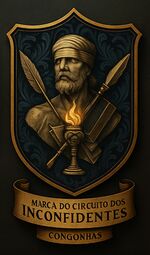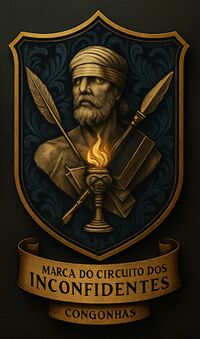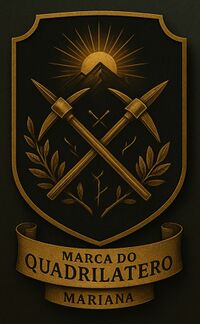Category:Domain:Ouro Preto, Brazil
Contents
- 1 THE COURT | A CORTE
- 2 High Chamber | Alta Cúpula
- 3 Harpy Officer | Harpiato
- 4 Council Table | Mesa do Conselho
- 5 Ordo Bellorum | Defesa, Vigilância & Guerra
- 6 Members of Aliança dos Quatro Altares | Membros da Aliança dos Quatro Altares
- 7 Members of Alvorada Mineira | Membros da Alvorada Mineira
- 8 Members of Circuito dos Inconfidentes | Membros do Circuito dos Inconfidentes
- 9 Members of Quadrilátero de Ferro | Membros do Quadrilátero de Ferro
- 10 Founder Elders | Anciões Fundadores
- 11 Principality Elysium | Elísio Principal
- 12 Other Elysium | Outros Elisios
- 13 Três Veredas Region (Anarchy Territory) | Região de Três Veredas (Território Anarquista)
- 14 Triângulo Mineiro (Giovanni Territory) | Triângulo Mineiro (Território Giovanni)
- 15 Jequitinhonha Valley (Outcast Territory) | Vale do Jequitinhonha (Território Independente)
- 16 Veil of The Queen (Camarilla Territory) | Manto da Rainha (Território Camarilla)
- 17 North Crown (Camarilla Territory) | Coroa Norte (Território Camarilla)
- 18 Others | Outros
- 19 Antagonists | Antagonistas
- 20 Domains / Marches | Dominios / Marcas
- 21 Other Territories | Outros Territórios
- 22 Domain History | Historia do Dominio
THE COURT | A CORTE
High Chamber | Alta Cúpula
Prince
Toreador
Victoria AppleyardSeneschal & Marquise of Aliança dos Quatro Altares
Gangrel
Helena d'AvalorMarquis of Quadrilátero de Ferro
Nosferatu
Jorhan StahllMarquise of Alvorada Mineira
Toreador
Satine RousseauMarquis of Circuito dos Inconfidentes
Brujah
Jean-Luc BatailleHarpy
Toreador
Veronica PetrusConsul Legatus
Assamite
Kalida Malika Ahmed MazdaDux Bellorum
Malkavian
Yamazaki KaedeImperial Keeper
Brujah
Alex DupontArcane Master
Clan
VAGO
Harpy Officer | Harpiato
Harpy
Toreador
Veronica PetrusLesser Harpy
Gangrel
Luther WagnerLesser Harpy
Toreador
Danka SevieriLesser Harpy
Malkavian
Armando PintoLesser Harpy
Nosferatu
Virgínia "Vó Folha" Mont'Claire
Council Table | Mesa do Conselho
Primogen
Assamite
Joana BolívarPrimogen
Brujah
Ezekiel "Red Smoke" BlackwaterPrimogen
Gangrel
Silas MornPrimogen
Malkavian
Dom Pedro LicurgoPrimogen
Nosferatu
Zé Bafo BagualPrimogen
Tremere
Astrid KjaerholmPrimogen
Ventrue
Lord Johan Von Stradivarius
Ordo Bellorum | Defesa, Vigilância & Guerra
Dux Bellorum
Malkavian
Yamazaki KaedeSheriff (Aliança)
Gangrel
Tauane SaraibaSheriff (Alvorada)
Lasombra Anti
Allen WalkerSheriff (Circuito)
Brujah
Natália Beatriz RochaSheriff (Quadrilátero)
Nosferatu
Corvys MagnusScourge
Gangrel
Khared-Jin el'NocturScourge
Nosferatu
LJ Vaimacá
Members of Aliança dos Quatro Altares | Membros da Aliança dos Quatro Altares
|
Members of Alvorada Mineira | Membros da Alvorada Mineira
|
Members of Circuito dos Inconfidentes | Membros do Circuito dos Inconfidentes
|
Members of Quadrilátero de Ferro | Membros do Quadrilátero de Ferro
|
Founder Elders | Anciões Fundadores
|
|
Galeria de Principes | Princes Gallery
Toreador
Almérico dos Reis
1st (1711-2001)Brujah
Nikandros Karpos
2nd (2001-2013)Ventrue
Lucas Bonfim
3rd (2013-2024)Assamite
Ryah Massoud
4th (2024)Lasombra Anti
Andrew Newak
5th (2025)Toreador
Victoria Appleyard
6th (2025-Now)
Principality Elysium | Elísio Principal
Elysium | Elísio "Museu da Inconfidencia"
'''EN-US'''
Museum of the Inconfidência
"Memory of Freedom. Heart of Shadows."
The Museum of the Inconfidência, located in the historic city of Ouro Preto, Minas Gerais, is one of Brazil’s most important historical institutions. Housed in the former House of Council and Jail of Vila Rica, the building was inaugurated in 1944 by President Getúlio Vargas as a tribute to the Inconfidentes — especially Joaquim José da Silva Xavier, known as Tiradentes — and to honor the struggle for independence and liberty in Brazil. The architecture is a hallmark of Brazilian colonial baroque. The museum holds a rich collection of 18th and 19th-century artifacts: documents, sacred sculptures, furniture, art, and objects from the Gold Cycle era. Beneath it lies the Pantheon of the Inconfidentes, where the remains of the movement’s martyrs rest, turning the museum into a national memorial. But there is another story — less known, never taught in schools — that unfolds beneath the surface. Within those same walls breathes a secret as old as the land: the Museum of the Inconfidência is also the oldest Elysium of the Empire of the Golden Arch, a vampiric domain whose influence stretches across southeastern Brazil. Since colonial times, the building has served as a sanctuary of neutrality for Kindred. No Disciplines may be used without permission. No violence is tolerated. No lie goes unnoticed. Elders roam the halls like shadows preserved in time. The Crimson Council, the vampiric senate of the Empire, holds its formal hearings in the grand hall, now a solemn chamber for eternal decisions. The Pantheon, viewed by mortals as a sacred tomb, is for the Kindred a crypt of bindings. Whispers claim that not only human martyrs lie there — but also ancient traitors of the Blood, sealed in ceremonial urns protected by forgotten Iberian runes, etched in vitae. Thus, the Museum of the Inconfidência lives a double existence: It is the visible symbol of the human fight for liberty. And the invisible bastion of eternal dominion. Between baroque and blood, between memory and manipulation, the Elysium stands as a secret cathedral. Ouro Preto may sleep — but its shadows never do.
'''PT-BR'''
Museu da Inconfidência
"Memória da Liberdade. Coração das Sombras."
O Museu da Inconfidência, localizado na cidade histórica de Ouro Preto, Minas Gerais, é um dos mais importantes museus históricos do Brasil. Instalado no antigo prédio da Casa de Câmara e Cadeia de Vila Rica, o edifício foi inaugurado em 1944, por iniciativa de Getúlio Vargas, como uma homenagem aos participantes da Inconfidência Mineira — especialmente Joaquim José da Silva Xavier, o Tiradentes — e à luta por liberdade e independência do Brasil. A arquitetura é um marco do barroco colonial brasileiro. A construção abriga um rico acervo de objetos dos séculos XVIII e XIX: documentos, esculturas sacras, móveis, obras de arte e utensílios do período do Ciclo do Ouro. O Panteão dos Inconfidentes, no subsolo, guarda os restos mortais de diversos conjurados, tornando o local não apenas um museu, mas um verdadeiro memorial nacional. Mas há outra história, menos conhecida, que corre em paralelo a essa — uma história que não se encontra nos livros escolares. Sob o mesmo teto que abriga a memória dos inconfidentes, pulsa um segredo ancestral: o Museu da Inconfidência é também o mais antigo Elysium do Império do Arco Dourado, um domínio vampírico cuja influência se estende por todo o sudeste brasileiro. A antiga Casa de Câmara e Cadeia é, desde tempos coloniais, um santuário de neutralidade entre os cainitas. Nele, nenhuma Disciplina pode ser usada sem autorização. Nenhuma violência é permitida. Nenhuma mentira escapa incólume. Os Anciãos caminham por seus salões como sombras preservadas no tempo. O Concílio Carmesim — o conselho vampírico que rege o coração político do Império — realiza suas audiências formais no antigo salão nobre, hoje silencioso palco de decisões eternas. O Panteão dos Inconfidentes, visto como túmulo sagrado pelos humanos, é para os vampiros uma cripta de selamentos. Diz-se que não apenas mártires humanos ali repousam — mas também traidores cainitas, selados em urnas cerimoniais sob antigas runas ibéricas, escritas em sangue. O Museu da Inconfidência, portanto, é duplo por natureza: É o símbolo visível da luta por liberdade. E é o bastião invisível do domínio eterno. Entre o barroco e o sangue, entre a memória e a manipulação, o Elysium se mantém de pé como uma catedral secreta. Ouro Preto dorme — mas seus segredos jamais descansam.
Other Elysium | Outros Elisios
(EN-US)
(PT-BR)
Três Veredas Region (Anarchy Territory) | Região de Três Veredas (Território Anarquista)
Baroonese of Três Veredas
Ravnos
Val YankharaAnarch
Brujah
Andreza GarciaAnarch
Brujah
Rogue
Triângulo Mineiro (Giovanni Territory) | Triângulo Mineiro (Território Giovanni)
Consiglieri
Giovanni
Barbara MillinerMembro
Giovanni
Horácio Paterna PutanescaMembro
Giovanni
Maria Auxiliadora PutanescaMember
Giovanni
Beatrice MillinerMember
Giovanni
Edoardo Colleoni MillinerMember
Giovanni
Monica di Ghiberti Milliner
Jequitinhonha Valley (Outcast Territory) | Vale do Jequitinhonha (Território Independente)
Upper Jequitinhonha
Toreador
Bento MorseGem Valley
Brujah
Kakita HayatoHollow Valley
Gangrel
Madre RocinaWarfront Border
Nosferatu
Antônio LaszloTrade Route
Ravnos
O InvestidorThe Mid
???
Xica da Silva
Veil of The Queen (Camarilla Territory) | Manto da Rainha (Território Camarilla)
Prince
Toreador
Lady Lavigne MontparnasseSeneschal
Ventrue
Val AlbuquerqueHarpy
Malkavian
Clarice Von SondheimSheriff
Nosferatu
M.Q.A - MaqaraScourge
Brujah
Babi CastroKeeper of Elysium
Toreador
LuMa CordeiroPrimogen
Brujah
Dama do FogoPrimogen
Malkavian
Soraya AbdalPrimogen
Nosferatu
Ravenna YgrittePrimogen
Toreador
Dona Beja
North Crown (Camarilla Territory) | Coroa Norte (Território Camarilla)
Prince
Brujah
Johann AskannisSeneschal
Malkavian
Farhad RomaHarpy
Lasombra Anti
Sebastian de ValmontSheriff
Brujah
Donnata FerriPrimogen
Brujah
Katrina RomanovPrimogen
Malkavian
Angélica TrindadePrimogen
Nosferatu
Kahn Al-KhanPrimogen
Toreador
Colonel Karin Van Deer HossenIndependente
Samedi
Abadir Abnara
Others | Outros
Guardian
Wraith
EwaoMama Loa
???
Ana MariaUNKNOWN
Unknown
Cheshire QUNKNOWN
Unknown
MaurícioSubterrain
???
Chico Rei
Antagonists | Antagonistas
Unknown
Unknown
Lord EuriMage
Healer
AkenaiWerewolf
Croatian Mafia
LinoUNKNOWN
Unknown
Isabella MartiniMage
Guardian
Renan AzevedoUnknown
Unknown
Olivier DeverauxFae
Occultist Mafia Leader?
CashmereMage
???
Niagara Mama Wa NtoMage
???
Maitê de Castro
Domains / Marches | Dominios / Marcas
THE GOLDEN EMPIRE / GOLDEN ARCH Imperial Seat: Ouro Preto The Empire is divided into five Marches and one Anarch Region (former March), each with political, strategic, and symbolic roles. Each March is ruled by a Marquis/Marquise, a Land Keeper, and a Sheriff, as well as an Imperial Councillor who represents their region in the Central Court, as Regional Primogen.
March of Aliança dos Quatro Altares
Main City: Tiradentes
Significance: The so-called Lands of the Inconfidência, this March form a historical and supernatural belt in the heart of Minas Gerais. Known among historians as the birthplace of the Inconfidência Mineira movement, this region is, for those familiar with the World of Darkness, an ancient political battleground between clans and ideologies.
Other Notable Cities: São João del-Rei, Barbacena, Prados, Santa Cruz de Minas.
March of Alvorada Mineira
Main City: Alvinópolis
Significance: Named among the Clans as the "Alvorada Mineira", this area is more than mortal territory: it represents a zone of armed neutrality, of deep artistic and ritualistic influence, marked by the subtle — and relentless — presence of the Kindred. It earned the nickname "The Mineiran New Orleans" not merely as poetic comparison, but because it harbors the meeting point between past and future, between faith and superstition, between art and death — all tempered by the nocturnal whisper of the Danse Macabre.
Other Notable Cities: João Monlevade, Ponte Nova, Nova Era.
March of Circuito dos Inconfidentes
Main City: Congonhas
Significance: This region is a blend of Contemporary Luxury and Colonial Rustic, a cradle of Minas Gerais’ history, blending baroque tradition, industrialization, and folklore. But beneath the surface — and behind the backdrop of churches and mountain ranges — pulses a second history, woven from echoes, pacts, conspiracies, and power, where the wars of the living resonate in the shadows of the undead. Known as the “Circuito dos Inconfidentes,” in both metaphorical and historical reference to the legacy of the Inconfidentes, which echoes through the social structures of both mortals and Kindred alike.
Other Notable Cities: Conselheiro Lafaiete, Queluzito, Santana dos Montes, Ouro Branco, São Brás do Suaçuí.
March of Quadrilátero de Ferro
Main City: Mariana
Significance: Stage of the Praxis Seizure by the Founding Toreador Prince Almérico Reis, the Quadrilátero was considered the First Official March in the territorial expansion from Ouro Preto. It holds great importance due to its rare mineral resources and supernatural materials. Additionally, it is under national surveillance as it is a UNESCO World Heritage Site.
Other Notable Cities: Itabira, Sabará, Nova Lima e Moeda.
The Imperial Seal
Main City: Ouro Preto
Significance: The Prince’s Throne, diplomatic, ceremonial, and spiritual heart of the Empire. Home to imperial archives, the Imperial Seal, and the soul of territorial unity.
Other: No other cities, as the region is a neutral, isolated core.
Other Territories | Outros Territórios
Três Veredas Regional (Anarch Territory)
Main City: Resende Costa
Significance: A Former March, Três Veredas is a liminal zone, an ancestral wound in the heart of Minas Gerais, where three roads meet to cross the past, present, and future of the supernatural. Though forgotten by the Camarilla and avoided by the Sabbat, the region pulses with a life of its own — raw, ancient, and uncontrollable.
Other Notable Cities: Coronel Xavier Chaves e Dores de Campo.
Triângulo Mineiro (Giovanni Territory)
Main City: Uberlândia
Significance: The Triângulo Mineiro is a region of singular relevance, for the routes it connects and the flows of economic and spiritual power it harbors beneath its fertile soil. It was granted by Andrew Newak to the Giovanni not merely as a political agreement, but in recognition that only those who master the secrets of death and silence could maintain control over a territory so dense with life, death, and influence — especially after the War against the Shadowlands. A poisoned gift, perhaps, but one given with strategic precision and clear expectations.
Other Notable Cities: Uberaba, Araguari, Ituiutaba, Monte Carmelo e Romaria.
Jequitinhonha Valley (Outcast Territory)
Main City: Diamantina
Significance: The Independent Lands of the Jequitinhonha are an ancestral mosaic of silent pacts, where the Empire watches without ruling, legends hold as much power as vampires, and any imbalance could awaken forces older than the Camarilla itself — with Diamantina as the cursed heart that beats between shadows, memories, and secrets never truly buried.
Other Notable Cities: Serro, Medina, Pedra Azul, Teófilo Otoni, Nanuque.
Upper Parnaíba (Camarilla Territory)
Main City: Patos de Minas
Significance: Upper Parnaíba is a rural, conservative domain under Camarilla control, led by Dom Eliseu Vasquez, yet marked by growing internal tensions. Beneath a facade of stability and thriving agribusiness, underground forces advance: Setites infiltrate Patrocínio, infernalist cults whisper in Coromandel, and the dormant legend of Dona Beja in Araxá threatens to awaken old alliances. Though officially loyal to the Empire of the Golden Arch, Upper Parnaíba is a stage for silent disputes, where conservatism hides ancient pacts, secret cults, and external pressures that could erupt at any moment.
Other Notable Cities: Araxá, Patrocínio, Coromandel, Carmo, Serra do Salitre.
North Crown (Camarilla Territory)
Main City: Montes Claros
Coroa Norte is an independent and fiercely Brujah-dominated domain, led by Johann Askannis, whose reign is maintained through military strength and ancestral pride. Despite a declared Pax with the Empire of the Golden Arch, tensions remain constant, with the region serving as a volatile frontier of political provocations. Cities like Montes Claros and Janaúba are bastions of resistance and memory, while ancient forces stir in the caves of Jaíba and Matias Cardoso. In Coroa Norte, the desert, the old faiths, and the rage of the oppressed blend into a powder keg, ready to ignite against internal conspiracies or imperial ambitions.
Other Notable Cities: Janaúba, Jaíba, Januária, Bocaiúva, Matias Cardoso.
Domain History | Historia do Dominio
EN-US
THE EPIC OF THE GOLDEN ARCH - A Chronicle of Shadows and Blood
Act I – The Lands of the Deep Soul
"Before iron, before fire, the earth breathed."
In ancient times, when the moon was younger and the stars whispered secrets to men, the lands that would become the Empire were sacred. The peoples of the forests and rivers—Xacriabás, Maxacalis, Krenak, and Aranãs—walked under the blessing of the spirits. Gold slept in the bowels of the earth, and the shamans warned: "If ever they tear out its heart, darkness will awaken."
But the white men came with their crosses and swords, and the blood of the innocent watered the soil.
Act II – The Gold Cycle
"With gold came blood, with blood the empire was born."
Behold, the bandeirantes, ravenous for riches, tore open the earth and enslaved its children. Vila Rica rose as a beacon of opulence and sin, its golden churches hiding shadows that fed on the sweat of the condemned. In dungeons and alleys, the first vampires, the Kindred, whispered alliances, while mortals raised altars to a God who did not hear them.
Ouro Preto became the heart of power, but beneath its streets, something ancient and hungry waited.
Act III – Rebellion and the Marches
"Freedom is a dream even the dead pursue."
When the rebels cried for liberty, the vampires listened. Not out of love for justice, but for opportunity. In the shadows, the proto-Marches emerged—alliances of blood and territory, where Gangrel, Ventrue, and Toreador vied for the right to rule. The mortal Crown fell, but the Empire of Shadows endured, weaving its dominion through the underworld of history.
Act IV – The Forge and the Fracture
"The fire of industry burns even souls."
The 20th century brought machines that roared like demons and smokestacks that spewed fumes across the sky. Ipatinga, Divinópolis, Itabira—cities forged in steel, where Nosferatu ruled the sewers and Gangrel commanded the railroad tracks.
And amid the chaos, Três Veredas, a refuge for the outcasts, the Damned, those who would not kneel. There, the Anarchs raised their banner, and the Empire, for now, tolerates... but war breathes in the dark.
Act V – The Golden Arch
"A throne is not eternal, but fear is."
Andrew Newak, the Prince of Shadows, rules with an iron hand and cold eyes. His reign nears its end, and Ibrahim Karaslam, the heritage, the unknown—approaches the Throne.
Five Marches obey, each with its Marquis, its LandKeeper, its Sheriff. But in the streets of Três Veredas, the nightfolk whisper: "The Golden Arch is cracking."
Epilogue – What is to Come
"No empire lasts forever. But some fall faster than others."
The Central Court gathers in Ouro Preto, while the Anarchs test their limits. Ancient blood still flows in the veins of the earth, and the dead shamans murmur: "The darkness always returns."
PT-BR
A EPOPEIA DO ARCO DOURADO - Uma Crônica de Sombras e Sangue
Ato I – As Terras da Alma Profunda
"Antes do ferro, antes do fogo, a terra respirava."
Nos tempos imemoriais, quando a lua era mais jovem e as estrelas sussurravam segredos aos homens, as terras do que viria a ser o Império eram sagradas. Os povos das florestas e dos rios—Xacriabás, Maxacalis, Krenak e Aranãs—caminhavam sob a bênção dos espíritos. O ouro dormia nas entranhas da terra, e os xamãs advertiam: "Se um dia arrancarem seu coração, a escuridão despertará."
Mas os homens brancos chegaram com suas cruzes e suas espadas, e o sangue dos inocentes regou o solo.
Ato II – O Ciclo do Ouro
"Com o ouro veio o sangue, com o sangue nasceu o império."
Eis que os bandeirantes, famintos por riquezas, rasgaram a terra e escravizaram seus filhos. Vila Rica ergueu-se como um farol de opulência e pecado, suas igrejas douradas escondendo sombras que se alimentavam do suor dos condenados. Nas masmorras e becos, os primeiros vampiros, os Kindred, sussurravam alianças, enquanto os mortais erguiam altares ao Deus que não os ouvia.
Ouro Preto tornou-se o coração do poder, mas sob suas ruas, algo antigo e voraz esperava.
Ato III – A Rebelião e as Marcas
"A liberdade é um sonho que até os mortos perseguem."
Quando os inconfidentes clamaram por liberdade, os vampiros ouviram. Não por amor à justiça, mas por oportunidade. Nas sombras, as proto-Marcas surgiram—alianças de sangue e território, onde Gangrel, Ventrue e Toreador disputavam o direito de governar. A Coroa mortal caiu, mas o Império das Sombras permaneceu, tecendo seu domínio nos subterrâneos da história.
Ato IV – A Forja e a Ruptura
"O fogo da indústria queima até as almas."
O século XX trouxe máquinas que rugiam como demônios e chaminés que cuspiam fumaça sobre o céu. Ipatinga, Divinópolis, Itabira—cidades forjadas em aço, onde os Nosferatu reinavam nos esgotos e os Gangrel comandavam os trilhos dos trens.
E no meio do caos, Três Veredas, refúgio dos desgarrados, dos Malditos, dos que não se ajoelhariam. Lá, os Anarquistas ergueram sua bandeira, e o Império, por enquanto, tolera... mas a guerra respira no escuro.
Ato V – O Arco Dourado
"Um trono não é eterno, mas o medo, sim."
Andrew Newak, o Príncipe de Sombras, governa com mão de ferro e olhos frios. Seu reinado chega ao fim, e Ibrahim Karaslam, dito herdeiro, o desconhecido se aproxima do Trono.
Cinco Marcas obedecem, cada uma com seu Marquês, seu LandKeeper, seu Xerife. Mas nas ruas de Três Veredas, o povo da noite murmura: "O Arco Dourado está rachando."
Epílogo – O que está por vir
"Nenhum império dura para sempre. Mas alguns caem mais rápido que outros."
A Corte Central reúne-se em Ouro Preto, enquanto os Anarquistas testam seus limites. O sangue antigo ainda corre nas veias da terra, e os xamãs mortos sussurram: "A escuridão sempre retorna."
Pages in category "Domain:Ouro Preto, Brazil"
The following 19 pages are in this category, out of 19 total.








































































































